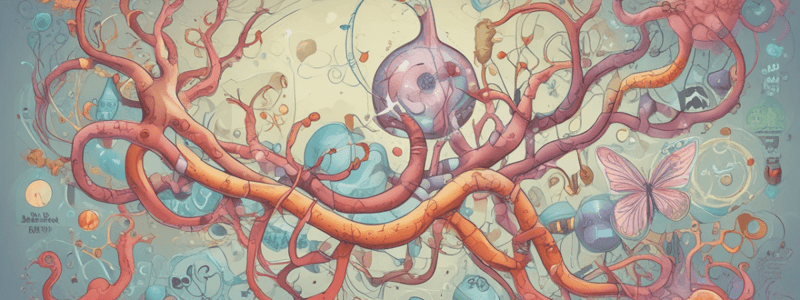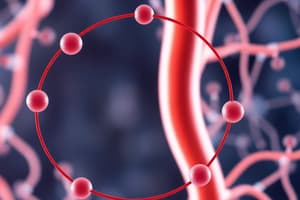Podcast
Questions and Answers
What is the primary purpose of oxygen utilization in aerobic tissues?
What is the primary purpose of oxygen utilization in aerobic tissues?
- To reduce H2O2 to H2O by cytochrome oxidase
- To generate ATP through substrate-level phosphorylation
- To carboxylate CO2 in the TCA cycle
- To reduce H2O by cytochrome oxidase (correct)
In the TCA cycle, how many reactions produce ATP from ADP?
In the TCA cycle, how many reactions produce ATP from ADP?
- Two
- None (correct)
- One
- Three
Where does the oxidation of NADH and FADH2 produced in the TCA cycle occur?
Where does the oxidation of NADH and FADH2 produced in the TCA cycle occur?
- In the mitochondrial matrix
- On the inner mitochondrial membrane (correct)
- In the cytosol
- In the mitochondrial intermembrane space
What is the characteristic of the electron transport chain in terms of electron affinity and redox potential?
What is the characteristic of the electron transport chain in terms of electron affinity and redox potential?
What would be the effect on ATP synthesis if the inner mitochondrial membrane becomes freely permeable to protons?
What would be the effect on ATP synthesis if the inner mitochondrial membrane becomes freely permeable to protons?
What would be the effect on NADH levels if the electron transport chain is inhibited?
What would be the effect on NADH levels if the electron transport chain is inhibited?
What is the primary product of the pyruvate dehydrogenase reaction?
What is the primary product of the pyruvate dehydrogenase reaction?
What is the role of oxaloacetate in the TCA cycle?
What is the role of oxaloacetate in the TCA cycle?
What is the purpose of the dehydrogenase enzymes in the TCA cycle?
What is the purpose of the dehydrogenase enzymes in the TCA cycle?
What is the result of the metabolic events of the TCA cycle?
What is the result of the metabolic events of the TCA cycle?
What is the central role of acetyl-CoA in the metabolism of glucose, fatty acids, and amino acids?
What is the central role of acetyl-CoA in the metabolism of glucose, fatty acids, and amino acids?
What is the role of the TCA cycle in the cell?
What is the role of the TCA cycle in the cell?
What is another name for the TCA cycle?
What is another name for the TCA cycle?
Which of the following statements about the TCA cycle is TRUE?
Which of the following statements about the TCA cycle is TRUE?
What is the byproduct of the TCA cycle?
What is the byproduct of the TCA cycle?
In which stage of catabolism does the TCA cycle occur?
In which stage of catabolism does the TCA cycle occur?
What is the enzyme that catalyzes the conversion of citrate to isocitrate?
What is the enzyme that catalyzes the conversion of citrate to isocitrate?
Which of the following is NOT a function of the TCA cycle?
Which of the following is NOT a function of the TCA cycle?
How many ATP molecules are generated from the complete oxidation of one acetyl-CoA molecule in the TCA cycle?
How many ATP molecules are generated from the complete oxidation of one acetyl-CoA molecule in the TCA cycle?
Which enzyme catalyzes the conversion of α-ketoglutarate to succinyl-CoA?
Which enzyme catalyzes the conversion of α-ketoglutarate to succinyl-CoA?
What is the purpose of the Electron Transport Chain?
What is the purpose of the Electron Transport Chain?
Which of the following is an irreversible reaction in the TCA cycle?
Which of the following is an irreversible reaction in the TCA cycle?
What is the primary function of the electron transport chain in oxidative phosphorylation?
What is the primary function of the electron transport chain in oxidative phosphorylation?
What is the role of the F0, F1-ATP synthase in oxidative phosphorylation?
What is the role of the F0, F1-ATP synthase in oxidative phosphorylation?
What is the effect of increased ADP levels on the rate of electron transport in oxidative phosphorylation?
What is the effect of increased ADP levels on the rate of electron transport in oxidative phosphorylation?
What is the difference between inhibitors and uncouplers of oxidative phosphorylation?
What is the difference between inhibitors and uncouplers of oxidative phosphorylation?
What is the P:O ratio for the reoxidation of NADH in oxidative phosphorylation?
What is the P:O ratio for the reoxidation of NADH in oxidative phosphorylation?
What is the role of the electron carriers in the electron transport chain?
What is the role of the electron carriers in the electron transport chain?
What is the effect of cyanide on the electron transport chain?
What is the effect of cyanide on the electron transport chain?
What is the function of the mitochondrial inner membrane in oxidative phosphorylation?
What is the function of the mitochondrial inner membrane in oxidative phosphorylation?
What is the net ATP yield from the complete oxidation of one glucose molecule?
What is the net ATP yield from the complete oxidation of one glucose molecule?
What is the role of coenzyme Q in the electron transport chain?
What is the role of coenzyme Q in the electron transport chain?
Study Notes
Aerobic Metabolism: TCA Cycle and Oxidative Phosphorylation
- The TCA cycle, also known as the Krebs cycle, Citric acid cycle, or Tricarboxylic acid cycle, is a key process in aerobic metabolism.
- The TCA cycle is a common terminal pathway for the catabolism of sugars, fats, and amino acids.
- The TCA cycle occurs in the mitochondrial matrix of all tissues with mitochondria, except for red blood cells and white muscle fibers.
TCA Cycle Reactions
- The TCA cycle consists of 8 enzyme-catalyzed reactions that convert acetyl-CoA into CO2.
- The reactions involve the conversion of acetyl-CoA to citrate, isocitrate, α-ketoglutarate, succinyl-CoA, succinate, fumarate, malate, and oxaloacetate.
- The TCA cycle produces NADH and FADH2 as reduced cofactors, which are essential for energy trapping and biosynthesis.
Energy Yield of TCA Cycle
- The TCA cycle produces 3 NADH and 1 FADH2, which result in a net gain of 12 ATP through oxidative phosphorylation.
- The TCA cycle also produces 1 GTP, which is equivalent to 1 ATP.
Electron Transport Chain and Oxidative Phosphorylation
- The electron transport chain is a series of electron carriers with increasing electron affinity and decreasing redox potential.
- The electron transport chain is located in the inner mitochondrial membrane.
- Oxidative phosphorylation occurs when the electrons from NADH and FADH2 are passed through the electron transport chain, resulting in the synthesis of ATP from ADP and Pi.
Irreversibility of Key Stages
-
Three enzyme steps in the TCA cycle are highly exergonic and irreversible: citrate synthase, isocitrate dehydrogenase, and α-ketoglutarate dehydrogenase.### Electron Transport Chain
-
The electron transport chain is a process of transferring H atoms to oxygen, located in the mitochondria, and occurs in most tissues and cell types, except for red blood cells.
-
The function of the electron transport chain is to trap energy and directly phosphorylate ADP to produce ATP.
Mitochondrial Compartments
- Oxidative phosphorylation takes place in association with the inner compartments of the mitochondria.
- The components of the electron transport chain are "buried" in the inner mitochondrial membrane.
NADH and NAD+
- NADH is the reduced form of nicotinamide adenine dinucleotide, with 2H atoms.
- NAD+ is the oxidized form of nicotinamide adenine dinucleotide.
Stepwise Transfer of H Atoms to O2
- The stepwise transfer of H atoms to O2 involves the transfer of 2H atoms from NADH to O2, resulting in the formation of H2O.
Components of the Electron Transport Chain
- H pair acceptors: Flavin cofactors, Coenzyme Q (CoQ).
- Electron acceptors: Iron sulphur proteins, Cytochrome proteins.
The Electron Transport Chain
- The electron transport chain consists of complexes I, III, and IV, which pump protons across the membrane, creating a proton and an electrochemical gradient.
- The energy of the proton gradient is used for the synthesis of ATP from ADP by the F0, F1- ATP synthase.
ATP Synthesis
- The mechanism of ATP synthesis involves the transfer of electrons from the electron transport chain to ATP synthase, resulting in the formation of ATP from ADP and Pi.
Control of Electron Transport
- The rate of electron transport is controlled by the levels of ADP and ATP, described as respiratory control, or 'tightly-coupled' oxidative phosphorylation.
- Increased [ADP] increases the rate of O2 uptake, while increased [ATP] decreases O2 uptake.
Inhibitors and Uncouplers
- Inhibitors of oxidative phosphorylation: CN-, rotenone, CO.
- Uncouplers of oxidative phosphorylation: dinitrophenol (DNP), thermogenin protein in brown adipose tissue.
ATP Production
- The complete oxidation of 1 molecule of glucose results in the production of 32 or 30 x ATP.
- The ATP yield from NADH reoxidation is 2.5 ATP, and from FADH2 reoxidation is 1.5 ATP.
Studying That Suits You
Use AI to generate personalized quizzes and flashcards to suit your learning preferences.
Description
Assess your knowledge of cellular respiration and the TCA cycle with these questions. Learn about the role of oxygen in aerobic tissues, NADH production, and more.




